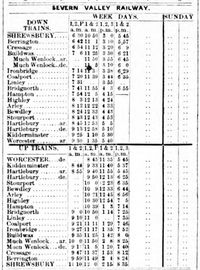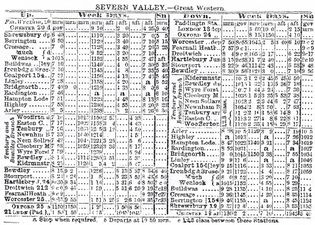Timetables in commercial service
This page provides details of the timetables in commercial service on the Severn Valley and Tenbury branches between opening in the 1860s and closure in the 1960s.
Contents
Introduction
At opening on 1 February 1862 all services on the Severn Valley Branch ran 'north south' between Hartlebury and Shrewsbury. There were 12 intermediate stations with just five crossing points, at Stourport, Bewdley, Bridgnorth, Ironbridge and Buildwas.
The main developments on the Branch which affected timetables over the years were:
- 1864: The Tenbury and Bewdley Railway opened, with Bewdley forming its eastern terminus.
- 1868: Eardington Station opened.
- 1878: The Kidderminster Loop Line opened, resulting in Bewdley becoming a junction station.
- 1883: Passing loops and second platforms were added at Arley and Hampton Loade.
- 1894: Passing loops and second platforms were added at Cressage and Berrington.
- 1896: A passing loop and second platform was added at Coalport.
- 1905 Halts were opened on the Loop Line at Rifle Range Halt (closed again in 1920) and Foley Park
- 1930s: In an attempt to increase local custom, halts were opened at Burlish, Northwood, Jackfield and Cound. Alveley Halt was also opened to serve Alveley Colliery, although it was not shown in public timetables.
After the Loop Line opened in 1878, services continued to run entirely 'north south' on the Severn Valley Branch and 'east west' between Kidderminster and the Tenbury Branch until the turn of the century. The early 1900s saw the introduction of local services between Kidderminster and Bewdley, and Bewdley and Hartlebury; at the same time some Shrewsbury services began to run to Kidderminster.
Many services on the Severn Valley Branch started and terminated at Worcester, particularly in the early years. However for consistency, journey times and speeds referred to below are those on the Branch itself between Hartlebury and Shrewsbury, unless otherwise stated. References to 'Weekday services' include Saturdays.
1860s
- Main article: Timetable: Shrewsbury to Worcester 1862
At opening on 1 February 1862, the Severn Valley Railway was operated under lease by the West Midland Railway (WMR). Their first timetable provided for three trains per day between Shrewsbury and Worcester on weekdays, together with a departure from Bridgnorth to Shrewsbury in the morning, returning in the late afternoon (no source has been found to confirm whether the stock was stabled at Bridgnorth overnight or whether an ECS move was involved). Journey times between Hartlebury and Shrewsbury averaged 2h 07min for the 40 miles, or less than 19 mph. The first departure of the day from Worcester and Shrewsbury was deemed to be a 'Parliamentary' train (see below).
There was no Sunday service during February 1862,[1] but thereafter one train ran from Worcester to Shrewsbury in the morning, returning in the late afternoon.[2]
- Main article: Timetable: Severn Valley and Tenbury Branch 1866
On 1 August 1863 the WMR was amalgamated with the GWR, who took over the operation of the Severn Valley Branch. They also operated the Tenbury and Bewdley Railway from its opening on 13 August 1864. On the Severn Valley Branch in 1866, four through trains ran each way between Shrewsbury and Worcester on weekdays, with average journey times between 1h 40min and 2h 5 min. The fastest journey time, the 2:45pm from Hartlebury, was achieved by by means of Arley, Highley, Linley, Cressage and Berrington being treated as request stops.
On the Tenbury Branch, three trains per day ran between Woofferton and Bewdley on weekdays only.
1870s
The GWR board minutes around this time regularly referred to communications being received requesting better services, normally followed by the note "This cannot be acceded to at present".[3]
The 1872 timetable still included four return workings between Hartlebury and Shrewsbury with a single service on Sunday. The first train from Hartlebury to Shrewsbury, the fastest at 1h 39min, was followed by the slowest at 2h 33min with other journey times averaging around 2 hours. All trains included first and second class accommodation, but only two of the four included provision for third class passengers.[4]
- Main article: Timetable: Severn Valley Branch 1876
The 1876 timetable showed only minor changes in timings from 1872, although the slowest service was now only 2h 22min between Hartlebury and Shrewsbury.
- Main article: Timetable: Severn Valley and Tenbury Branch 1877"
1877 again saw only minor changes to the 1876 timetable, although the fastest time between Hartlebury was now 1h 42min.
- Main article: Timetable: Severn Valley and Tenbury Branch 1878"
1878 saw the opening of the Kidderminster Loop Line. The Severn Valley Branch continued with the four return workings on weekdays and one service on Sundays as before, although some changes were made to timings, following which for the first time the average time for southbound journeys at 1h 56 min was faster than for northbound at 2h 03min.
On the Tenbury Branch, five services now ran each way between Woofferton and Kidderminster on weekdays; there was still no Sunday service. All journeys from Shrewsbury via Bridgnorth to Kidderminster therefore required a change of trains at Bewdley.
'Parliamentary' trains
William Gladstone's Railway Regulation Act 1844 provided for a basic minimum standard of railway travel by compelling railway companies to provide at least one train per day in each direction over their lines, stopping at all stations, at an average speed of not less than 12 mph including stops, at a fare not exceeding a penny per mile in carriages adequately protected from the weather. These became known as 'Parliamentary trains' or 'Cheap trains'. For some time they were unpopular with the railway companies who often arranged for them to run at inconvenient times of day.
References to these 'Parliamentary' trains could often be found in published timetables. For example the 1862 timetable published in the Shrewsbury Chronicle showed the class of carriages on each train, normally either "1 & 2" or "1,2,3". However first departure from Shrewsbury and Worcester is shown as "1,2,P". The timetables for 1866, 1877 and 1887 all have trains labelled "gov" (presumably standing for "Government") which met the requirement of stopping at all stations.
By 1875 the Midland Railway had upgraded the standard of third class and abolished second class,[note 1] with other companies soon following suit. Thereafter there was no longer a need to run 'Parliamentary' or 'Cheap' trains, although for many years railwaymen would, by tradition, continue refer to particular services in those terms. During the notorious Quintinshill accident in 1912, Signalman Meakin, realising the cause of the first collision, exclaimed to his colleague "You've got the 'Parly' standing there."
See also
Notes
- ↑ The law required third class accommodation to be provided, which brought about the oddity of carriages having first and third but no second class. This persisted until third class was rebranded by BR as 'second' in 1956, and subsequently as 'standard'.
References
- ↑ Timetable extract
- ↑ Nabarro (1971) p. 67.
- ↑ Marshall (1989) pp. 138-144, 161-164.
- ↑ Vanns (1998) p. 95.

